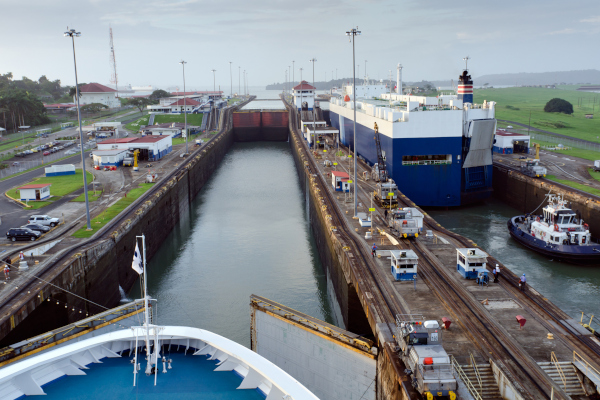While the backlog of ships waiting to travel through the Panama Canal has eased slightly, continued drought conditions in the region have resulted in the Panama Canal Authority extending daily transit and vessel restrictions through the end of this year and into 2024, Reuters reported.
Overall, vessel wait times are at 164.5 hours in September, down from 228 minutes in August. But with the end of rainy season in Panama this month, the prospect of enough rain falling to restore water levels to pre-drought conditions is slim. Water levels in Gatun Lake, which the Canal draws its water from, are at 79.7 feet, off from 87.41 feet a year ago. Typically, water levels are 89 feet at the end of rainy season.
The Canal Authority emphasized this week that total vessel crossings are more than 800 ahead of year-to-date projections, and vessel traffic in September has represented a normal level for the time of year.
However, some shippers are concerned, and that has them looking for alternatives to avoid material or product delays. AlixPartners, citing data from CNBC, noted that 40% of U.S. container traffic comes through the Panama Canal.
To deal with the lower water levels, the Panama Canal Authority has restricted ships to a water draft depth of 44 feet, compared to 50 feet under normal conditions. That has led some ships to carry less cargo.
“Shippers should expect to see delays in freight arriving at the U.S. East Coast and Gulf ports if the current pace of freight through the Panama Canal continues. Shippers should not expect the delays to resolve themselves anytime in the near-term future – so you should act now if your freight is impacted,” AlixPartners wrote in a recent blog.
To help shippers navigate the current crisis, AlixPartners offered five areas to explore as a disruption mitigation strategy. They are:
1. Prioritize freight visibility for shipments
2. Evaluate if your supply chain has the flexibility to absorb potential delays
3. Explore alternative options
4. Align on processes to prioritize goods internally
5. Communicate potential cost exposure.
“The current situation highlights the importance of planning for overall supply chain resiliency. Relying on one lane or mode too heavily presents a risk,” AlixPartners wrote. “You never know which component will struggle – and we’ve seen examples of this time after time – Evergreen in the Suez Canal, West Coast COVID impacts, ocean rate spikes, and port labor challenges in Canada.”
The consulting firm provided more detail on each of these areas in the blog posting. You can read the full blog and tips here.
SC
MR


More Ports & Shipping
- U.S.-bound containerized import shipments are up in June and first half of 2024
- Building resilience in manufacturing
- One door closes, a better one opens
- AI liftoff delayed?
- The key to good data management? Start with good data
- Procter & Gamble’s Amy Rardin announced as NexGen Supply Chain keynote speaker
- More Ports & Shipping
Latest Podcast

 Explore
Explore
Topics
Procurement & Sourcing News
- AI-driven sourcing: Why the speed of change is going to only accelerate
- A Silk Road city
- U.S.-bound containerized import shipments are up in June and first half of 2024
- Boeing turned to Fairmarkit, AI to help land its tail spend
- When disaster strikes, the supply chain becomes the key to life
- A smarter approach to sustainability is vital for healthy, resilient supply chains
- More Procurement & Sourcing
Latest Procurement & Sourcing Resources

Subscribe

Supply Chain Management Review delivers the best industry content.

Editors’ Picks




